You might have heard about APIs a countless number of times either in interaction with the developers or while working in the tech industry. But have you ever wondered what api means? It has been around for quite a long time but has become popular recently. Almost all the software platforms have APIs that allow developers to access the platform data and integrate it with their systems.
You use it for almost everything like booking tickets, logging in to your social media accounts, for payments, ordering food, etc. Companies and businesses are using APIs for moving ahead of their competitors by retrieving data faster than others and serving their customers better.
In this blog, analyzing we will understand api definition, how api works, what different tools are used to manage APIs, and which features are significant for the api development.
Let’s begin our astonishing journey of APIs.

What is an API?
An API or application programming interface is a programming bridge that allows two software or applications to talk to each other. It is a set of programming instructions that allows an application to interact with other apps or platforms and use their functions or database information to enhance user experience and performance.
Let’s understand with an example:
When you try and use social sign-ups/logins (e.g. Login via Facebook, Google, Twitter, etc) the app does not require you to create an account with all your personal details. The app simply communicates with the social platform to fetch the user information based on the authentication provided. This whole process of user sign-up and onboarding is possible only because the social platforms have provided APIs for developers to use and integrate, it’s usually called one-click sign-up/sign-in.
Why are APIs so important?
APIs have become a very integral part of a developer’s day-to-day work. API has enabled cross-platform business solutions. For eg now you are not limited to using EMIRATES or HILTON for flight & hotel bookings separately, a user can check both of these and many other options from BOOKING.COM. Online payments are now not limited to only BANK PORTALS, a user in India can use UPI to pay from any of his bank accounts using a 3rd PARTY application like PAYTM or PHONE PE. All these innovations have been possible because of APIs and their optimal integrations.
Let’s, for discussion’s sake, consider a situation “IF API WERE NOT AVAILABLE” how would the technological world look like?
Below are a few industries that would cease to exist, if APIs were not available
- Social Media:
The millennials of the 21st century are social media-centric. Social media platforms like Facebook, Twitter, and Instagram help you to easily upload and edit your pics, videos, and posts. APIs play an important role in making social media platforms work smoothly. May it be APIs of Instagram, Facebook, TikTok, Snapchat, etc. These social platforms have tons of 3rd party apps that totally rely on these official APIs and any change to the APIs or the rules for these platforms, affects the business of thousands of 3rd party apps, plugins, and add ons.
- Youtube and OTT:
During the lockdown, the world has seen a massive increase in the popularity of OTT video platforms and Youtube. It is expected that by 2026, there will be around 3,930 million users on the OTT video platform. OTT platforms like Netflix, HotStar, Amazon Prime have gained such huge popularity due to the APIs. The major traffic on these platforms are catered on mobile devices which totally rely on APIs. Above these, the whole revenue model of these OTT platforms rely on adverts. The platforms have been using either own or 3rd party ad tools to integrate into their system which again is only possible with APIs.
- Online Booking:
Earlier you have to be in long queues for booking tickets, whether traveling tickets or movie tickets. But in the past decade, the online ticket booking platform has seen tremendous growth. Now you can book cross-platform tickets from apps like Booking.com, Make My Trip, Paytm, etc. anytime and anywhere at your fingertips. APIs have made all this possible and helped the online travel booking platforms in becoming a $517.8 billion industry.
- eCommerce:
Online retail has a strong presence in the whole world. Since lockdown, online shopping has gained immense popularity among people. eCommerce companies like Amazon, Flipkart, eBay, and Myntra have seen tremendous growth in the past couple of years. Retail eCommerce sales are estimated to reach about $7.4 trillion by 2025. This all has been made possible by APIs. APIs have made the process of ordering, purchasing, shipping, and the payment of the orders very smooth and user-friendly.
Terminologies in API Development, that you should know
1. REST:
REST or representational state transfer is a programming architectural style or the rules for developing web API for client-server applications. REST API is highly scalable, flexible, and has a fast execution time for the call requests to the API. The advantage is that for the execution of REST API user doesn’t have to remember parameters and the names of the functions in a specific order.
2. JSON:
JSON or JavaScript Object Notation is a data-interchange format that explains the clients about requesting and editing the data from the server and shows the server how it can respond to these requests. It helps in interchanging the data between two or more applications or web servers.
3. API Key:
An API key is a unique identification code that helps to authenticate your project with an API. This key is for the tasks or applications that are automated. It is generated using Alphanumeric and special characters and should be kept secret for avoiding misuse.
4. Endpoint:
When an API interacts with other systems, the location at which the API sends requests to the resources for accessing them is called endpoint. It can be a URL of a server or service.
5. OAuth:
It is an open-standard user authorization protocol that uses access tokens for proving the identity of the service providers and consumers without sharing any security credentials.
6. SOAP:
Simple Object Access Protocol is a standard messaging protocol that uses XML data format for sending and receiving web service requests and responses. The advantage of SOAP API is that it is independent of the platform and programming language.

How does an API work?
API is a set of rules or protocols that defines the communication between two or more devices, apps, and machines. It acts as a middle link between the server and the user.
Let’s understand how does API work using an example:
Suppose you have to book train tickets for traveling. You will log in to the ticket booking app. Then you will fill the form with details like boarding, destination and date, and journey and then submit it. Within a few seconds, you will see the list of the trains for your destination with details like timings, price, seat availability, etc. Have you ever thought about how this magic happens?
The app sends the call request to the Train website for accessing the relevant data via API. Then the server sends back the data to the platform via API to be displayed on the screen.
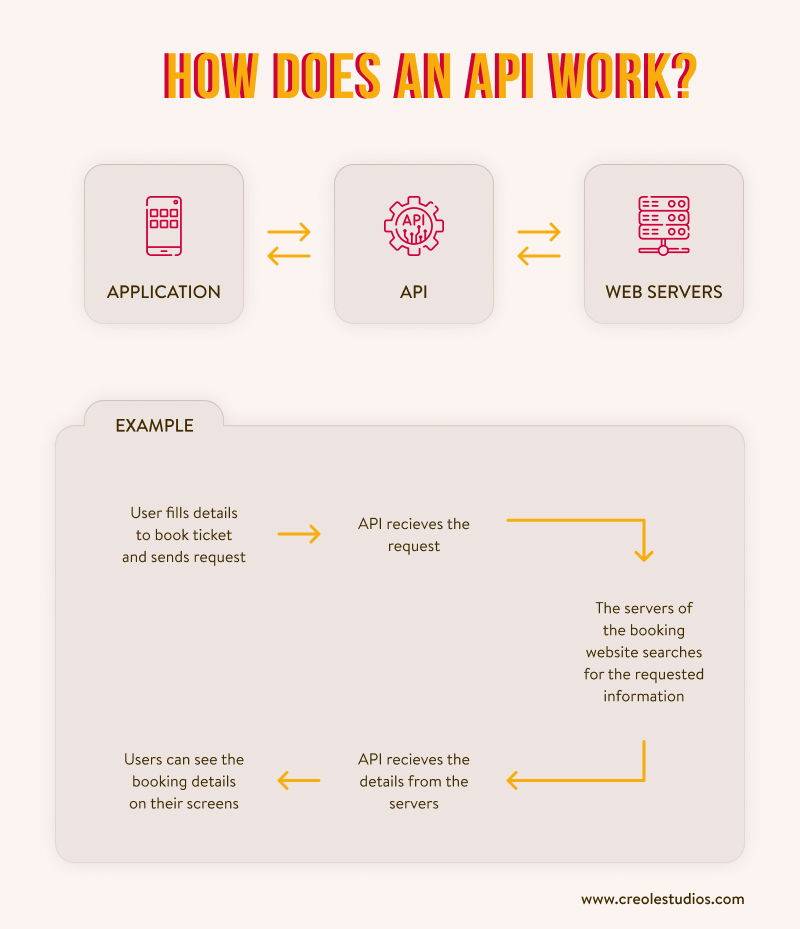
Mobile App → API → Train website → API → Mobile App
(user requests) (request) (server) (response) (display of trains)
APIs generally communicate with the endpoints using either REST or SOAP.
Top 5 Tools for Managing APIs
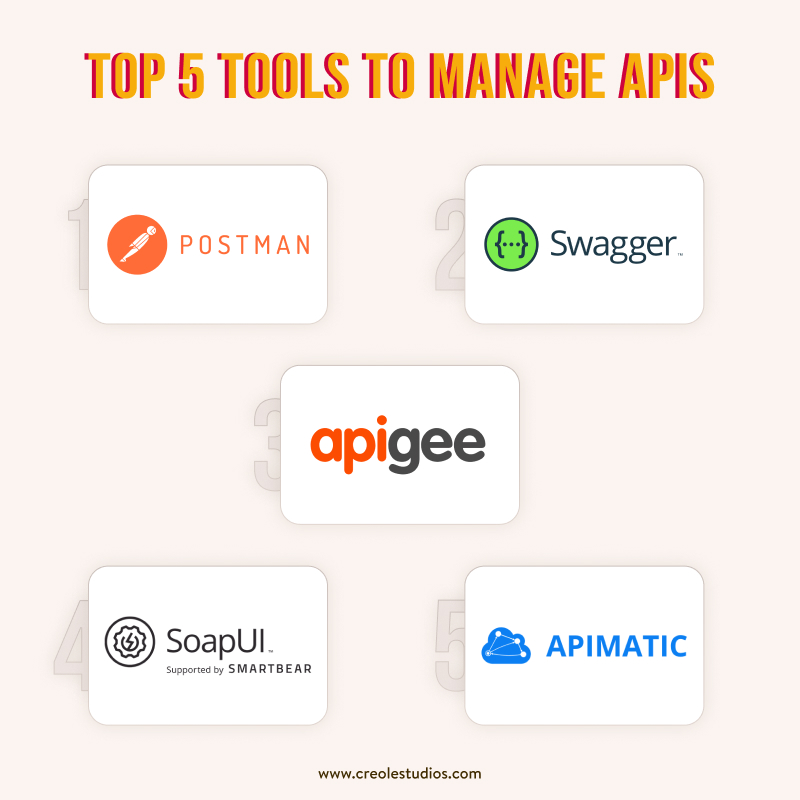
Let’s take a look at some of the popular tools that we use to manage APIs for our clients:
1. Postman:
Postman is an interactive and automatic tool used for API design, testing, documentation https://www.postman.com/product/tools/. You can use its very friendly GUI for obtaining various types of responses that are to be validated. It is very scalable and easily integrates into CI/CD pipeline.
2. Swagger:
Swagger is an open-source Interface Description Language used for describing the structure of your REST APIs so that they are machine-readable. It is used for designing, building, automated documentation of RESTful web services.
3. Apigee:
Apigee is Google’s API interface for API development and management. It helps developers create connected apps by allowing the data exchange between cloud services and applications. It also generates reverse proxies using the URL of the backend services.
4. SOAP UI:
SOAP UI is an open-source cross-platform automation tool for testing Web services REST and SOAP APIs. It supports JavaScript and Groovy languages for creating and executing automated tests, load tests, and regression. It performs both functional and non-functional (security and performance) tests.
5. APIMatic:
It is a Developer Experience platform for generating top-grade code samples, SDKs, Test Cases, and dynamic codes using the specifications of the API.
Few pointers to make an API efficient
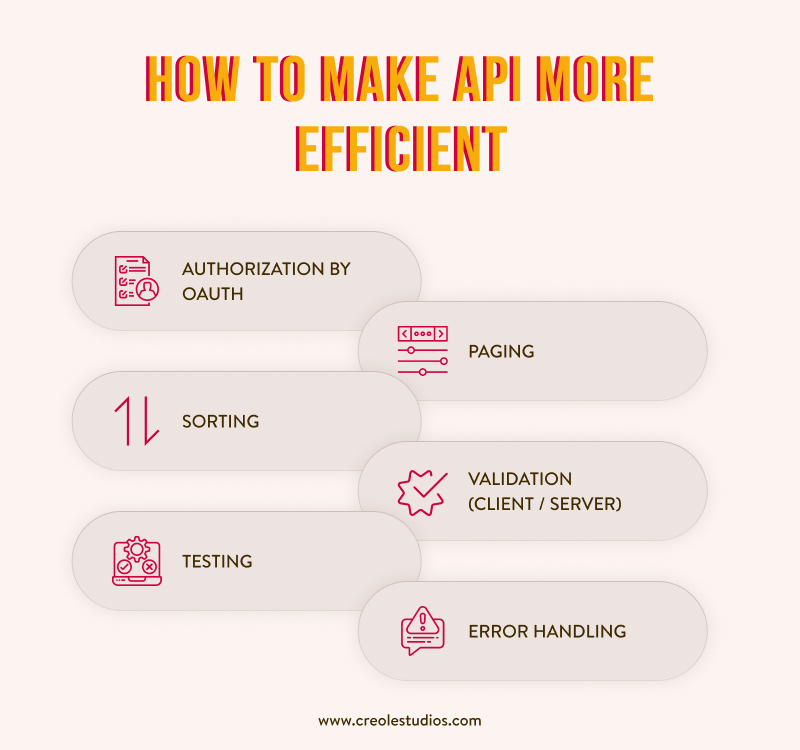
1. Authorization by OAuth:
Authorization is essential and used for verifying the user and his access to perform actions on a specific source. The Authorization via OAuth is comparatively faster than other sources just a click away. OAuth minimizes the processing time, provides high-level security and a better response time.
2. Paging:
It is the process of determining the frequency and the amount of data to be displayed. It also informs users about the remaining pages of data.
3. Sorting:
It gives assurance to the user that the data user is receiving is as per the requirement, condition, and modification. It works by reading a parameter’s value that shows the field which is used to sort the results.
4. Validation:
It is the quality verification of the data sent to the API or the correctness of the data. There are two types of validations for the APIs:
- Client-side validation:
The user performs it to catch the invalid data and fix it before sending it to the server. The users get prompt feedback for the incorrect entry, the corrections tooltip, etc.
- Server validation:
It is one of the most significant aspects of developing the APIs because the data from the client is not trustworthy, and the server can’t find out what happened on the client-side. It is used for validating the kind of property (email, etc.) and whether it is required or not.
5. Testing:
API Testing is the same as software or QA testing. One of the most effective ways of testing APIs is by using integration testing. The whole API logic is covered in the integration test flow by testing the API’s entry point and mocking the request time by service. You can focus on the logic layer’s code by using the mocks for running the tests and be independent of the presentation layer. If there are no dependencies, then the test automates easily, is more reliable, and is simpler to include in the integration pipeline.
6. Error Handling:
The debugging of APIs can be made easy by effective error handling. It helps to find if the error is from the client-side or the server. The client can resolve some of the errors by changing the request, but for others, he requires support.
Best Practices for API Development
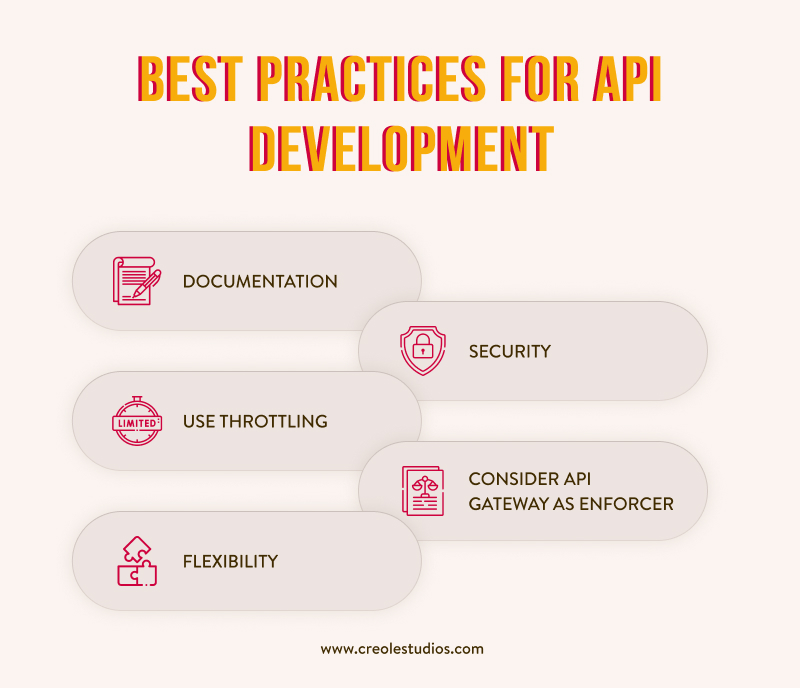
1. Documentation:
People generally hate writing documentation because it can be dull, and we are in accord. But from the user’s perspective, the one thing you or other developers will hate most will be working on an undocumented API.
When you write detailed and precise documentation of your API, it will help the other mobile app developers to easily understand the process and instructions while using or integrating with your API. You can also write concise tutorials for the developers to at least build a skeleton, then guide them towards the complete documentation of the functionalities of your API.
2. Security:
It is one of the essential parameters for building APIs. You must have a highly secure API but don’t compromise with user-friendliness. You can use token-based authentication for securing your API.
3. Use Throttling:
API throttling is the process of setting a limit to the number of requests a user makes in a given time. It creates backup for APIs, keeps it safe from DoS attacks, and redirects the traffic overflow.
4. Consider your API gateway as Enforcer:
API gateway works as a law enforcer for your API by allowing the data access to only the right users. It also helps in checking the API security by analyzing and managing the usage of your API.
5. Flexibility:
It is impossible to reckon all the possible ways users can use your API. You should provide flexibility or tolerance to the API with your input and output constraints because we know that not all client platforms have a great OAuth library, good JSON support, etc.

API Development Cost
If you are planning for API development then you should consider the following factors for determining the cost of building your API:
- Studying the existing system flow
- Documenting the API parameters
- Development time
- Experience of developer
- Usage of pre-built integration
- Using automation tools
- Services as per your requirements
From our experience, it should take around 6-8 man-hours for an experienced developer to develop one API. The given hours are excluding the man-hours spent in system understanding and documentation. If you want to know more, feel free to contact us. We would be more than willing to guide you.
Conclusion
In recent years, the significance of APIs has increased multi-folds. Earlier it was significant only from the software development perspective, but now it has to have a fair share in the business collaboration. We also believe that the development and integration of the API in the business sector have helped people enhance their business profits.
We hope now you have a fair idea about the API and how they work or what technologies are in API development. If you are interested in developing an API for your business or you have any queries related to how to create API for your project, then reach out to our experts and they will help you to guide you through as per your requirements.











 30 mins free Consulting
30 mins free Consulting 
 10 min read
10 min read 
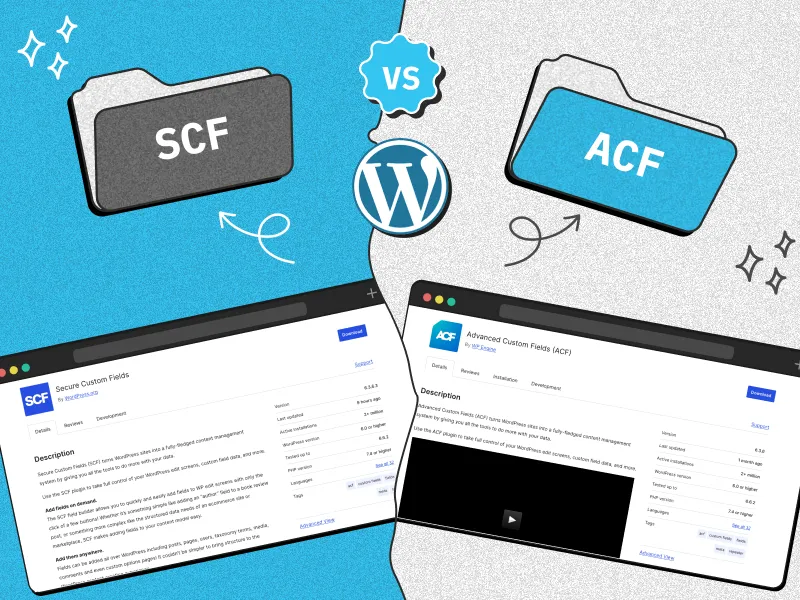

 Canada
Canada 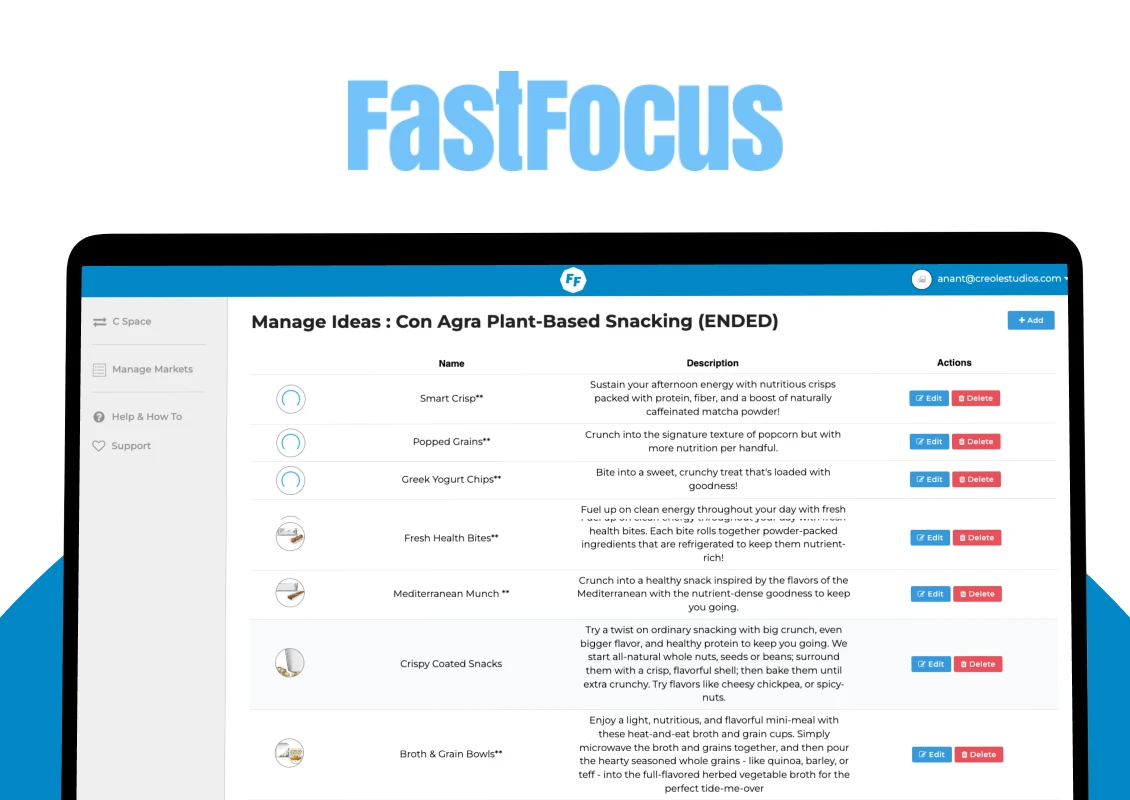
 USA
USA 






 Love we get from the world
Love we get from the world 